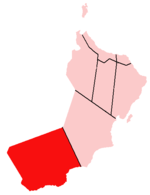 Governorates Governorates
Dhofar
The Dhofar region lies in Southern Oman, on the eastern border
of Yemen. Its mountainous area covers 99,300 km² and has
the population of 215,960 as of census 2003. The largest town
in the region is Salalah. Historically, it was the chief source
of frankincense in the world. However, its frankincense is now
mostly used locally. (Somalia is now the leading exporter.)
While Arabic speakers from the dominant
Omani culture have come to live in the province, especially the
larger cities and towns, Dhofar has been the traditional homeland
of many tribespeople speaking a variety of South Arabian Semitic
languages. One of the largest - spoken by the Qara (Ehkelô),
Shahra, Barahama, Bait Ash-Shaik and Bathira mountain tribes -
is called Shehri - popularly referred to as "SHAHRI people"
or "mountain talk". It is closely related to Mehri in
Yemen. Other indigenous groups speaking smaller languages such
as Bathari live in the coastal towns of Shuwaymiya and Sharbithat.
The Harasis, speaking Harsusi, number 1-2,000 and live in Jiddat
al-Harasis.
Al-Mahara in Yemen and Dhofar in Oman are
the only parts of south Arabia directly exposed to the South East
monsoon from mid August to late September or early October; this
is known as the khareef. As a result, it has a lush green climate
during the monsoon season and for sometime after until the vegetation
loses its moisture. Dhofar's temporarily wet climate contrasts
sharply with the neighboring barren Empty Quarter Desert. The
Salalah plain was once a well cultivated area with a sophisticated
irrigation system. During World War I it was fertile enough to
produce food and grain to supply a large proportion of the requirement
of the British Army fighting in Mesopotamia.
A counter-insurgency campaign was fought
here by the Sultan of Oman's Armed Forces (SAF) 1965-1975 against
guerrilla fighters of the Marxist National Democratic Front for
the Liberation of Oman and the Persian Gulf (NDFLOAG), supported
by Communist South Yemen after that territory's independence.
The rebel group was renamed the Popular Front for the Liberation
of Oman (PFLO) in 1974. It aimed to depose the Sultan. The Sultan's
forces, assisted by the United Kingdom, Iran, Jordan and India,
prevailed, and once the campaign was declared over in December
1975, the active remainder of PFLO forces surrendered.
In Mormon culture, Dhofar is the most popular
traditional location of the Book of Mormon land of Bountiful.
This association is not an official LDS Church doctrine, however.
Dhofar is a tribal community, home to many
ancient tribes. The Arab tribes include Kathiri tribes such as
Al Shanfari, Al-Rawas, Al-Marhoon, Al-Fadhil, Al-Hadhri, Al-Hubais,
Al-Rashdi other Arab tribes such as Al-Hashmeis, Al Yafei, Al-Masheekhy,
and more. The Qara/ Jebbali tribes include Al-Mashani (better
known for Mazoon Al-Mashani, mother of the Sultan of Oman), Bait
Said, Bait Tabouk, Bait Kashoob, Al-Amri, AL-SHARI and more.
It has been recently discovered that the
Dhofar region is rich in meteorites.
Administrative Divisions
Dhofar governorate consists of ten wilayat: Salalah, Taqa, Mirbat,
Thumrait, Sadah, Rakhyut, Dhalkut, Muqshin, Al Mazyoona, and Shlaim
and the Hallaniyat Islands.
|
|